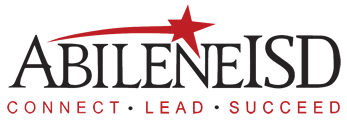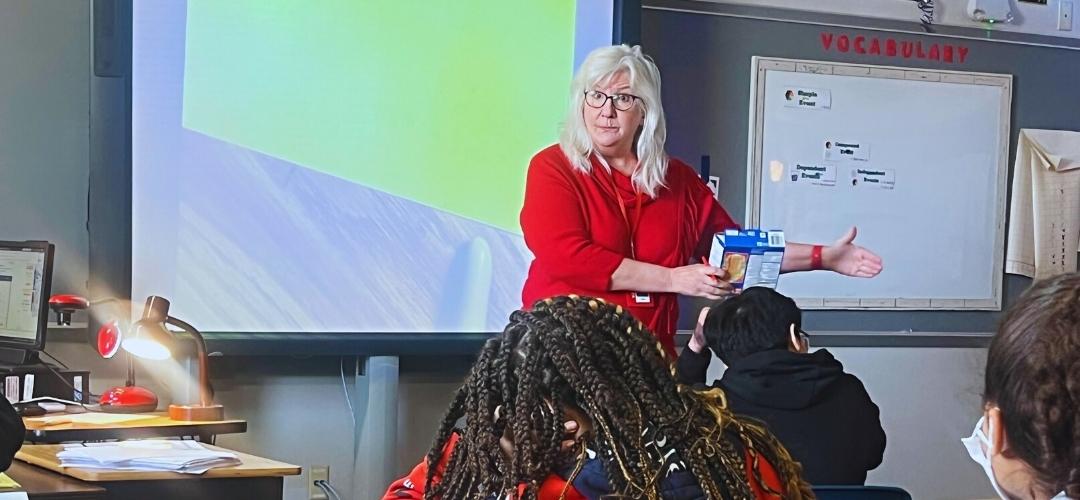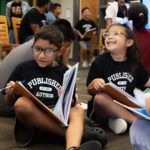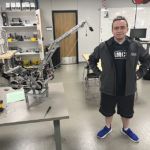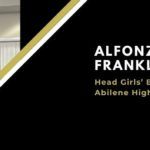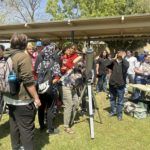Clack Middle School teacher Marie Schoonover has taught for 35 years in three different states and has seen learning programs and standardized testing of all kinds.
She’s seen them as a teacher, principal and school administrator in New York state and then as a teacher in inner-city New Orleans where she once had several 16-year-old 8th-graders who were almost hopelessly behind the rest of their classmates.
She arrived in Abilene prior to the 2020-21 school year, and after a year teaching at TLCA, Schoonover moved to AISD where she got a job teaching math at Clack. Now she’s teaching 6th-, 7th-, and 8th-graders in the district’s Bridge program, which is designed to support the social/emotional and academic needs for students who have fallen behind in their education.
Before taking the job, Schoonover said she had “lots of questions” for Clack principal, Dr. Chris Bailey, about the Bridge program and how it would work to help students be more successful in the classroom. What she heard excited her and motivated her to want to be part of AISD.
“Our class is half the size of a normal class and we have them for two periods (about 90 minutes) each day,” Schoonover said. “Those two things alone make such a huge difference. Also, we take them where they are and move them forward. All of that really appealed to me.”
She was also attracted to a job where the emphasis wasn’t placed on a standardized test, but, rather, on student success.
“In the New York, North Carolina and New Orleans, everything we did as teachers was geared toward the standardized tests,” she said. “North Carolina was really bad. If the administration didn’t see the progress on those tests they expected, you could be fired. There’s a lot of concentration on the test and do whatever it takes for everything to look good on paper. This program is so much different and so much better because success is measured differently.”
And while some days are difficult — as they are for any teacher in any district across the country — Schoonover loves working with the students at each level and meeting them where they are in the educational process.
“These kids I’m working with are the ones who tend to fall through the cracks,” she said. “They haven’t had a lot of success in the educational system, then you add COVID and the pandemic on top of that and it’s made it even more difficult on them.”
One of the teaching methods has found most effective with all students is to get them up and moving around the room. Even though it’s math and not P.E., she believes getting them moving gets them more involved in the lesson, stimulates their brains and makes the lesson more exciting.
“I try to be very creative with what we do in the classroom,” Schoonover said. “These kids just haven’t had much success, and when they get older, how are they going to try if they’ve never really been successful? Probably not very much.
“The first thing I thought was important was getting them to feel like they could be successful, and that took a while,” she said. “They’re coming at me with real holes in their education. Some of them even see teachers as the enemy. But as they get to know you and realize you care about them, they come around. They just want to be liked and find success.”
The alternative teaching methods that Schoonover employs have caught the attention of Bailey, who said that the interactive lessons have helped her reach her students in all three grades.
“Mrs. Schoonover gets her kids moving around the room and engaging in hands-on learning experiences that motivate them to learn,” he said.
One of those students – eighth-grader Amiya Mayes – said multiple factors have helped her in her final year before entering Cooper High School in the fall.
“The classes are longer and that gives you more time to finish the work,” she said. “The classes are smaller, and with less students in the room, you get more one-on-one time if you’re struggling. Mrs. Schoonover makes it fun and we’re moving around the classroom doing different things. I can tell that, for me, it’s made a big difference.”
And making a difference in the lives of students is what Bailey wanted to see from the Bridge program.
“We have seen many of our students that might have been disengaged during COVID-19 close gaps in learning and demonstrate growth from the previous year,” he said. “I’m really excited about this program and any program that meets kids where they are, gets them excited about learning, and celebrates the outcomes.”
Schoonover said she noticed right away that many of her students were missing a lot of fundamentals, attributable to the gap caused by the shutdown in March 2020.
“Our sixth-graders really have huge gaps, mostly in the foundations,” she said. “They struggle with math facts: decimals, percentages, etc. For example, I’ll be doing a lesson and realize they have no clue what an exponent is, even though we’re supposed to be doing more of that in middle school.
“I had to tell myself that my job was to get them over the hump and help them figure out I’m not the enemy,” Schoonover said. “It took them about two months and now they’re making strides. The biggest gain at the eighth-grade level has been that they’re simply trying to work and they care about their grades. That’s a huge improvement.”
As the 2021-22 school year begins to wind down over the last six weeks, Schoonover said she’s already beginning to think about the 2022-23 school year.
“I’d like to start next school year with more team building,” she said. “At some point, it would also be good for the kids to help me keep track of their own progress. Keep track of what they’re learning and how they’re learning.”
